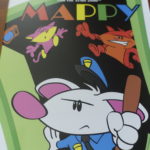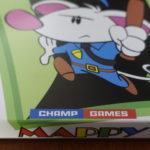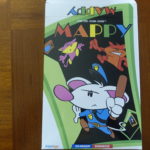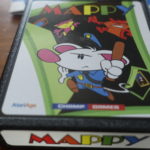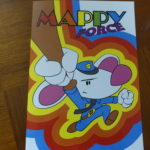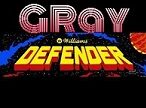Mappy Atari 2600 homebrew review by Champ Games!
Background
Mappy is a side-scrolling arcade video game created by Namco way back in 1983. It enjoyed great success in Japan and was much less popular here in the United States. In it, you play as a sort of Police mouse. In fact, the term Mappy is said to originate from the Japanese slang term for a policeman. The object of the game is to avoid all the burglar cats and retrieve all the items or loot they have stolen. The game has been re-released by Namco as a part of Namco collections and made its way to the Playstation, Xbox, PC, and Gamecube. My Arcade is currently selling a miniature version of Mappy, available at most retail outlets including Walmart and Target. There were also a couple of sequels released as well as an animated web series produced in 2013.
Mappy for the Atari 2600 was programmed by Champ Games original founder and president, “John Champeau“.
I was curious about how he finds the time to work on projects like this. So I asked him if he was working a full-time job and this was his response:
I am a software engineer for a company based in the US that does online transaction processing and fraud detection. Time is scarce which is why it takes about a year to do one of these games, plus the graphics/sounds are done by Nathan Strum and Mike Haas which helps out a lot so I can just focus on gameplay development.
I had the pleasure of meeting him at the 2017 Portland Retro Gaming Expo. After having signed my Super Cobra Arcade box, he whispers in my ear the title of his next big project, “Mappy“, but “keep it a secret for now”. He actually started on the initial designs for it back in 2001.
Mappy is a single-player game.
GAME DESCRIPTION
When you first power on Mappy, we are presented with the Atariage logo and tune. We are then brought to the title screen in which the games multi-colored name is proudly displayed, “Mappy“. I count five distinct colors one for each letter, red, orange-yellow, green, and blue.
Beneath the game’s title is an image of Mappy and the games starting difficulty is displayed just below that. Although it may not be obvious, you can switch the difficulty by pressing left or right on the joystick. The settings are “Novice“, “Standard“, and “Advanced“. More on that later.
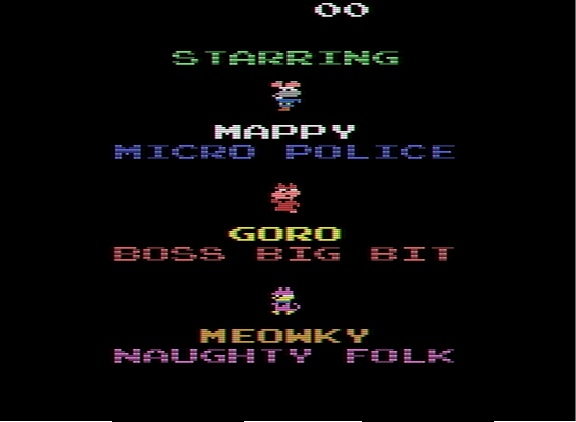
Waiting a few seconds you will see a credit screen introducing all the game characters, including “Goro“, the “Boss” big bit and “Meowky“, “Naughty Folk“. If you are observant you may notice it should read “Naughty Folks“. I asked John about that, he mentioned it was a limitation of the text display driver which is limited to just twelve characters.
Following the credit, the screen is the display of the high score tables. Pressing up or down on the joystick will toggle between the scores and credit screens.
An attract screen will then start up with the word “demo” flashing at the top of the screen, showing sample gameplay from a random stage for a few seconds before repeating back to the title screen.
There are 99 stages total to complete in Mappy after which if you make it that far a message will display and the game will end.
GAMEPLAY
In Mappy, the game’s environment is rendered as a cross-section of a house providing a viewport into the house and all its floors. Your available Mappys are represented by what looks like badges on the bottom left portion of the screen. On the bottom right is a level indicator represented by a balloon with your level number. This balloon will alternate colors as you progress through the various levels in the game. Of course, your score is displayed top center.
You can travel between the floors by jumping on trampolines. However, you can only jump on the trampoline a few times before it breaks. On each successive jump, it will change colors. It starts out green, then gray, then yellow, then red. Once it turns red you cannot jump on it without it snapping. The trampolines may regain their strength if some time is allowed to transpire. The cats cannot capture Mappy when jumping on a trampoline or when jumping off the ledge to the trampoline.
As you navigate through the house your mission is to pick up all the loot stolen by the cats while at the same time avoiding all the cats. Should a cat get too close, you will lose a Mappy. If you fall through any floor without a trampoline beneath it or if the trampoline breaks, you will also lose a Mappy. The game will end if you run out of all your Mappys or if you can complete all 99 levels!
You pick up the loot simply by having Mappy run into it. Mappy can open and close any doors on the same floor he is on as long as he is facing the direction of the door, pressing the fire button, Mappy will toggle the door open or closed. If any cats are near the door when opened, they will be temporarily stunned. If Mappy is too close to a door that is opened, he can also be pushed back by the door opening. There are special flashing doors on some of the floors. The first time they are opened, they emit a microwave horizontally basting across the level in the direction the door was opened. This microwave will temporarily eliminate any cats in its path. They will return a short while later, re-emerging from the attic. You are awarded bonus points based upon the number of cats nailed by the microwave.
You have to clear all the loot in the house in a timely fashion or a “hurry” mode will be activated. This is signified by a sound effect as well as a hurry message displayed on the screen. On the “standard” difficulty, this triggers after about 90 seconds. The game’s background music will speed up slightly as do the cat’s movements. Two extra cats will also drop down from the attic. After 60 more seconds transpire there will be a second “hurry up” message displayed, then the Gonsenzo coin will make its appearance. The coin will pursue and can kill Mappy. It will travel through doors and can kill Mappy even in the air. It is impervious. So, the bottom line, try to complete the level before the “hurry” mode is activated.
A bell may appear on the top left and right portion of a level. When Mappy reaches the bell from a trampoline, it will fall, temporarily stunning any cats in its path.
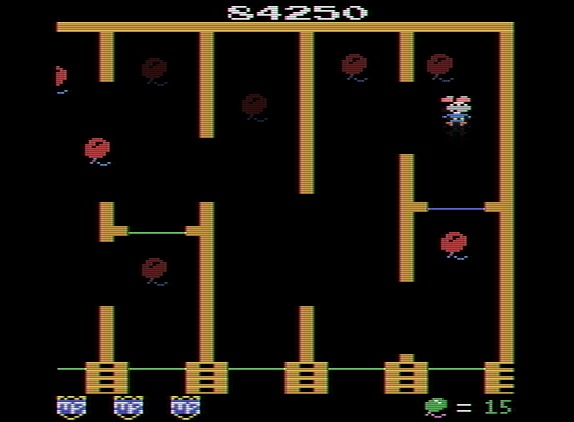
There are bonus balloon rounds that give you a small break in play starting with level three and then every fourth level following. In these bonus rounds, Mappy must navigate and bounce his way through a sort of maze, trying to pop all of the balloons before the music ends, to earn the maximum bonus possible. There are a total of four different bonus rounds which repeat in sequence. Starting at level 19, on the “standard” and “advanced” difficulties there are invisible bonus rounds in which the walls only appear briefly when Mappy bounces on the trampoline.
In the later Levels, specifically, 12, 13, and 14, trap doors make an appearance. They are to be avoided but Mappy can trap the cats in them. They always show up in the same spots, but in different locations, between levels 12, 13, and 14, and they will return every 16 levels.
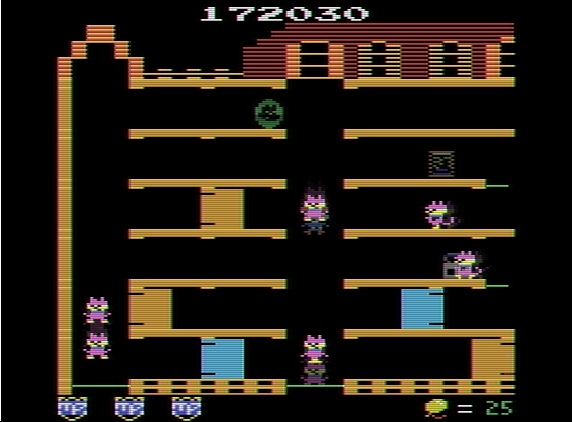
Controls
The game can be started by pressing fire on the joystick from the game’s menus or by pressing the console “RESET” at any time.
You control Mappy with a joystick pressing left or right to move horizontally. Jumping on the trampoline will move Mappy vertically between floors. Pressing left or right again will then land him on a new floor. Pressing the fire button opens and closes doors on house floors that Mappy is facing. Pressing fire will skip some of the text screens such as the beginning of the bonus rounds.
The game can be paused by toggling the BW/Color switch on the Atari 2600 console or by pressing pause on the Atari 7800, as with most of John Champeau’s ports such as Scramble and Super Cobra Arcade.
From the title screen pressing the joystick left or right cycles through the various skill levels on the title screen. “Game Select” returns to the title page and cycles through the difficulty settings.
Pressing up or down will switch between the top scores and credits screens.
Pressing “Reset” or the button on your joystick will start the game.
Overall the controls feel quite responsive. When I lose a Mappy I am not blaming it on the controls.
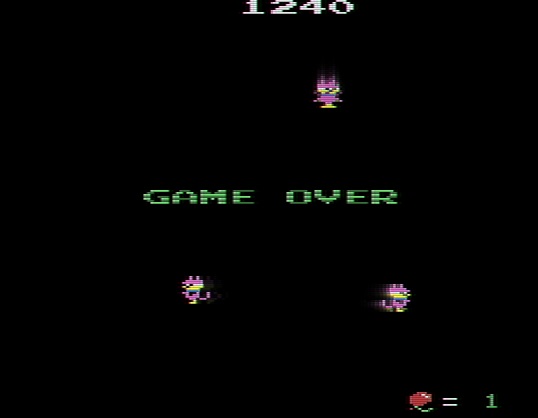
Scoring
You are awarded 10 points each time you jump on a trampoline, 50 for hitting a cat with a door, 300 for dropping a bell on a cat, 300 for dropping a cat through the trap door, and 1,000 for finding Goro hiding behind the loot.
I didn’t release the following until I had read the manual. The loot is spread throughout the map in pairs. Two Radios worth 100 each, Two TVs, 200 each, two Computers 300 each, two paintings 400 each, and two safes 500 each. To take advantage of the bonus multiplier you have to collect the loot in pairs. When you pick up one, the other one will start flashing. You will receive a bonus multiplier depending on how many times you do this, up to six times the regular bonus. All this time I was thinking the flashing was sprite flickering.
Capturing cats with the microwave awards points based on the number of cats captured starting out with 200 points for the first cat and building all the way up to 6,000 points if you capture 10 cats all at once.
The manual mentions, if Goro is captured, he counts toward the number of cats captured and will double the points awarded culminating with a maximum of 12,000 points possible by capturing all nine cats and the Goro with the microwave.
From the bonus stage, the red balloons are worth 200 points each, the Goro Balloon at the end of the stage is worth 2,000 and you will be awarded 5,000 bonus points for capturing all the red balloons and the Goro Balloon.
A bonus Mappy is awarded at 20,000 points, 50,000 points, and every 50,000 points thereafter.
Strategy
Although I am not that great a player of Mappy, here are my two cents. The floor edges seem to give Mappy a little bit of a break when it comes to the cats capturing him. After bouncing on a trampoline and selecting a floor to land on, if you have a cat on your tail you can land, then quickly jump back down to the trampoline to avoid being caught. Do not commit to a floor level if you do not know where all of the cats are. That way you will know if you can safely scroll to the other side of the house map. If you are not careful the cats can surround you on both sides. If this should happen and there is a nearby door you can close and reopen the door quickly to stun the cats opposite you and make your escape. I believe it’s a good strategy to save your microwave doors until you absolutely need to use them. Saving them also gives you time to put Mappy in a position to capture as many cats as possible per microwave door opening. Remember you can open the Microwave doors without having to be near them.
The balloon stages are very unforgiving, meaning you cannot make many, if any, mistakes and still complete the round 100%. You also have to learn and remember the specifics of snagging the last balloon on each bonus stage as it differs between stages. If you do make a mistake you can continue playing in some cases, you will not be able to attain the big bonus although you can still switch your main goal to securing the Goro Balloon since it is worth 2,000 points as opposed to the regular red balloons which are only worth 200 points each. Never go back to try to retrieve a missed balloon.
Difficulty Settings / Level Ramp Ups
There are three difficulty or skill levels:
NOVICE (Green): You start out with five lives. There are fewer cats to start, cats are slower, less aggressive, there is more time on the bonus screen and Goro hides behind the prizes longer. You also have more time on the bonus stages and the hurry timer is longer.
STANDARD (Blue): This is most like the arcade. You start with 4 lives and are battling against three cats plus Goro at the beginning.
ADVANCED (Red): You start out with four lives. Faster and more aggressive Cats, less time on bonus screens, Goro doesn’t hide as long behind prizes. And the Hurry timer is longer.
It’s worth noting that the gameplay speed notches up slowly as you progress further into the game. This is especially noticeable when Mappy is faster than the cats at first, then slowly, after completing several levels, Mappy is slower than most of the cats.
According to the manual, there are a few additional gameplay features thrown in on the Advanced levels. Some doors will reverse direction when closed. Trampolines will not completely repair giving Mappy less time to plan out his next move. Some doors will be replaced by walls that must be maneuvered around. The walls of the bonus stage can be invisible. They will appear briefly when Mappy bounces off a trampoline.
With the consoles left difficulty switch set to “A” the loot will be randomly placed throughout the house on each level. In position “B” the loot is located in the same position on each level.
The right difficulty switch has to do with the object flickering. When the consoles right difficulty switch is set to “A“, the objects flicker only if necessary. While in position “B” the objects flicker at a more constant rate.
Graphics
The graphics in Mappy are outstanding. Nathan Strum is credited to the graphics. The loot is finely detailed. You can easily make out what they represent. The radio looks like a radio, the TV looks like an old school television and even the painting looks like a painting of Mona Lisa.
The side-scrolling in this port of Mappy is noticeably smoother than in Scramble or Super Cobra Arcade. It still scrolls at the same resolution only twice as fast. This is key for smooth gameplay. The graphics emulate the Arcade version pretty closely. The sprites are multi-colored and animated. There are nice animations for Mappy walking, the cats, the trampoline, and a nice death or capture animation.
The title screen displays vivid colors and there was a lot of subtle detail placed into the game such as the Goro face placed into the balloon during the bonus round screens. You will also notice your balloon level indicator on the bottom right will change colors as you progress through the many levels in Mappy.
Sound
I noticed a significant improvement in the music and sound effects in this game as opposed to most Atari 2600 games. You will notice it right away as soon as you fire up the game. The sound effects sort of sound a little bit fuzzy and are unlike any other Atari game I have played, and I mean that in a good way.
When I asked John Champeau about the sound, this was his response.
The in-game music is using a sound driver that uses the DPC chip that was originally designed by David Crane for use in Pitfall 2 back in the ’80s. It’s a 3-voice music driver that plays on one of the Atari’s 2 sound channels. The sound FX are generated using the Atari’s internal sound chip (TIA) and played on the other sound channel. Mike Haas did the sound FX and the wave patterns used for the instruments in the music, as well as composing some of the music. Most of the notes for the music were derived from MIDI files using a converter that I developed (converts MIDI files into 3-channel data suitable for the DPC).
So based on that statement we are hearing midi sound effects converted and played through the Atari 2600 TIA chip. I should point out that Darrel Spice Jr. was credited for creating the sound driver. Overall it’s a pretty amazing accomplishment. During gameplay, a song is played in the background. It’s a great tune and never seems to get old. There is a different tune played upon completing the balloon stages, a nice tune is played when being awarded a spare Mappy and another tune is played upon the games ending. When you’ve finished the game and are entering your initials another great tune plays. There are several sound effects played during the game. There is a sound effect for picking up loot, one for the microwave being activated and another one for the when the bell strikes the cats. When the “hurry mode” is enabled, another sound effect is played and the background music speeds up slightly.
Atarivox / Save key support
Mappy continues the Champ Games tradition of save key and Atarivox support. The Savekey device saves your top five high scores PER skill level.
You have the ability to reset all the scores on the AtarVox / Savekey by pressing and holding “RESET” on the console while powering on the game.
Mappy remembers the current skill level you were last playing on and defaults to that skill level the next time you power on your system.
Suggestions for Improvements
This is such a well-polished game, I struggle to come up with any significant ideas for improvement. I would have liked the ability to toggle the sound off, even though I like the music quite a bit. There are a couple of minor deviations from the arcade such as alternating two-player support and having the high score display on the playing screen. Also in the arcade, there is a small instructional scoring demo missing here, probably due to cartridge size limitations. If I am ever so slightly critical, I would have liked for the Mappy and Gorro sprites to have been slightly larger. There have been more than a few times when I was playing Mappy and jumping on the trampoline with a bunch of cats and have lost track of where he is.
Packaging
The artwork for the boxed version of Mappy is colorful, unique, and beautifully done. Credit to Nathan Strum. The background is white with a cartoonish theme. Mappy appears to be passing through a trap door with two distant trap doors visible beneath him. He is being chased by two cats and two treasures are visible. This artwork is repeated on the game’s cartridge, manual, and on the included 10×14 poster with gorgeous artwork, again by Nathan Strum.
The description on the manual reads “Mappy Force“, an homage to the old Atari force comics that used to be included with some Atari games. So right away you know you are in for a treat. In the inside cover, there is a note on how to insert the game cartridge. Directly underneath it states:
“Disassembling microwave ovens for use in booby-traps is not recommended. Doing so may void your manufacturer’s warranty. Also, it’s probably really dangerous”
I love it. The first four pages are a humorous comic, which explains the game’s background story. The remaining pages 5 through 10 covers how to play the game like a regular manual only with more information than most.
Media Coverage
The youtube channel, “zero page homebrew” conducted an excellent interview with John Champeau during their visit to the 2018 Portland Retro Gaming Expo. So I suggest you check that out. Link in the description.
World Record
As this is a fairly new release, I was unable to locate any official World Record or even high score posting on the Highscore.com website. However, the Twin Galaxies website currently has the arcade world record listed as 2,313,890 by Mike Kasper, and there is a video of his gameplay posted.
Easter eggs
There are a few Easter eggs built into Mappy and I have been granted permission to reveal one of them here. It’s really more of a cheat than an Easter egg. Skip ahead about 6 seconds, if you want to discover it for yourself. If you hold down the controller button and press “GAME SELECT” during a level, Mappy will advance to the next level.
Conclusion
Mappy for the Atari 2600 is an amazing technological achievement that nobody would have even thought possible, especially back in the day. Champ games have done it again achieving yet another terrific release. As with all their other releases, Mappy exhibits great attention to detail and arcade accuracy. It plays and feels strikingly like the arcade version. Prior to this port, I was not really a fan of Mappy. I don’t think I really understood what it was all about. Now I can say with confidence, I am a huge fan of Mappy.
This game 32K cartridge uses a technology called DPC+, which is sort of an extension of a special chip that was used to create Pitfall II. It is described on Atariage as a
“Melody-enhanced game that takes full advantage of the CDF mode in the Melody”.
I am impressed with all the attention to detail that was placed into Mappy. The title screen colors match the arcade, the character sprites are all animated, there is an attract mode, the fact that there is a high score table for each difficulty, the amazing sound sampling, the bonus rounds, arcade accuracy, impressive packaging, all add up to what I believe is the best Atari 2600 homebrew released in 2018!
The complete in box version of Mappy is available for purchase through the Atariage web store for $50.00. John Champeau has said he will make the ROM freely available sometime next year.
Highly recommended.
I’d like to take this moment to thank John Champeau for being so responsive and answering all of my questions which helped me complete this review.
Credits
Code and Design: John W. Champeau
Graphics: Nathan Strum
Music and Sound Effects: Mike Haas
Music Driver: Darrell Spice, Jr.
Code Optimization: Thomas Jentzsch
Manual Text: Nathan Strum
Published by: Atariage
Youtube Description:
This is my review of Mappy for the Atari 2600. Learn all about this exciting new release. I even reveal one of the games Easter eggs.
Atariage store purchase link:
https://www.atariage.com/store/index.php?l=product_detail&p=1171
Zeropage Homebrew link:
https://www.youtube.com/watch?v=9sG5mEdsvZc
My review of John Champeaus Super Cobra Arcade for Atari 2600:
https://www.youtube.com/watch?v=Dlre_IFXtA4
Youtube Original Post Date: 12/24/2018


